Grigori Sidorov
Multilingual Sentiment Analysis of Summarized Texts: A Cross-Language Study of Text Shortening Effects
Mar 31, 2025Abstract:Summarization significantly impacts sentiment analysis across languages with diverse morphologies. This study examines extractive and abstractive summarization effects on sentiment classification in English, German, French, Spanish, Italian, Finnish, Hungarian, and Arabic. We assess sentiment shifts post-summarization using multilingual transformers (mBERT, XLM-RoBERTa, T5, and BART) and language-specific models (FinBERT, AraBERT). Results show extractive summarization better preserves sentiment, especially in morphologically complex languages, while abstractive summarization improves readability but introduces sentiment distortion, affecting sentiment accuracy. Languages with rich inflectional morphology, such as Finnish, Hungarian, and Arabic, experience greater accuracy drops than English or German. Findings emphasize the need for language-specific adaptations in sentiment analysis and propose a hybrid summarization approach balancing readability and sentiment preservation. These insights benefit multilingual sentiment applications, including social media monitoring, market analysis, and cross-lingual opinion mining.
Advancing Sentiment Analysis in Tamil-English Code-Mixed Texts: Challenges and Transformer-Based Solutions
Mar 30, 2025Abstract:The sentiment analysis task in Tamil-English code-mixed texts has been explored using advanced transformer-based models. Challenges from grammatical inconsistencies, orthographic variations, and phonetic ambiguities have been addressed. The limitations of existing datasets and annotation gaps have been examined, emphasizing the need for larger and more diverse corpora. Transformer architectures, including XLM-RoBERTa, mT5, IndicBERT, and RemBERT, have been evaluated in low-resource, code-mixed environments. Performance metrics have been analyzed, highlighting the effectiveness of specific models in handling multilingual sentiment classification. The findings suggest that further advancements in data augmentation, phonetic normalization, and hybrid modeling approaches are required to enhance accuracy. Future research directions for improving sentiment analysis in code-mixed texts have been proposed.
PRKAN: Parameter-Reduced Kolmogorov-Arnold Networks
Jan 13, 2025Abstract:Kolmogorov-Arnold Networks (KANs) represent an innovation in neural network architectures, offering a compelling alternative to Multi-Layer Perceptrons (MLPs) in models such as Convolutional Neural Networks (CNNs), Recurrent Neural Networks (RNNs), and Transformers. By advancing network design, KANs are driving groundbreaking research and enabling transformative applications across various scientific domains involving neural networks. However, existing KANs often require significantly more parameters in their network layers compared to MLPs. To address this limitation, this paper introduces PRKANs (\textbf{P}arameter-\textbf{R}educed \textbf{K}olmogorov-\textbf{A}rnold \textbf{N}etworks), which employ several methods to reduce the parameter count in KAN layers, making them comparable to MLP layers. Experimental results on the MNIST and Fashion-MNIST datasets demonstrate that PRKANs with attention mechanisms outperform several existing KANs and rival the performance of MLPs, albeit with slightly longer training times. Furthermore, the study highlights the advantages of Gaussian Radial Basis Functions (GRBFs) and layer normalization in KAN designs. The repository for this work is available at: \url{https://github.com/hoangthangta/All-KAN}.
Advanced Machine Learning Techniques for Social Support Detection on Social Media
Jan 06, 2025
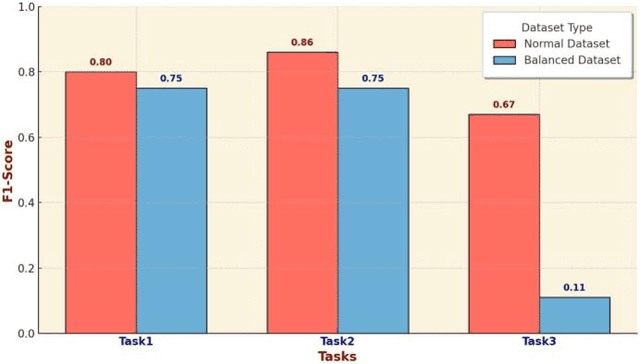

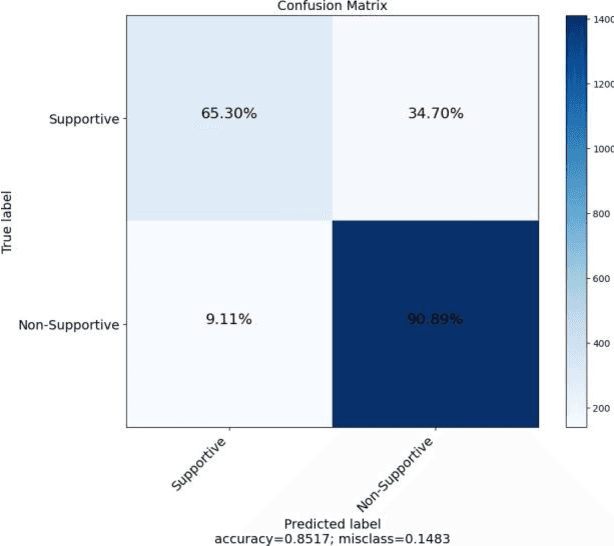
Abstract:The widespread use of social media highlights the need to understand its impact, particularly the role of online social support. This study uses a dataset focused on online social support, which includes binary and multiclass classifications of social support content on social media. The classification of social support is divided into three tasks. The first task focuses on distinguishing between supportive and non-supportive. The second task aims to identify whether the support is directed toward an individual or a group. The third task categorizes the specific type of social support, grouping it into categories such as Nation, LGBTQ, Black people, Women, Religion, and Other (if it does not fit into the previously mentioned categories). To address data imbalances in these tasks, we employed K-means clustering for balancing the dataset and compared the results with the original unbalanced data. Using advanced machine learning techniques, including transformers and zero-shot learning approaches with GPT3, GPT4, and GPT4-o, we predict social support levels in various contexts. The effectiveness of the dataset is evaluated using baseline models across different learning approaches, with transformer-based methods demonstrating superior performance. Additionally, we achieved a 0.4\% increase in the macro F1 score for the second task and a 0.7\% increase for the third task, compared to previous work utilizing traditional machine learning with psycholinguistic and unigram-based TF-IDF values.
Evaluating the Capabilities of Large Language Models for Multi-label Emotion Understanding
Dec 17, 2024Abstract:Large Language Models (LLMs) show promising learning and reasoning abilities. Compared to other NLP tasks, multilingual and multi-label emotion evaluation tasks are under-explored in LLMs. In this paper, we present EthioEmo, a multi-label emotion classification dataset for four Ethiopian languages, namely, Amharic (amh), Afan Oromo (orm), Somali (som), and Tigrinya (tir). We perform extensive experiments with an additional English multi-label emotion dataset from SemEval 2018 Task 1. Our evaluation includes encoder-only, encoder-decoder, and decoder-only language models. We compare zero and few-shot approaches of LLMs to fine-tuning smaller language models. The results show that accurate multi-label emotion classification is still insufficient even for high-resource languages such as English, and there is a large gap between the performance of high-resource and low-resource languages. The results also show varying performance levels depending on the language and model type. EthioEmo is available publicly to further improve the understanding of emotions in language models and how people convey emotions through various languages.
Social Support Detection from Social Media Texts
Nov 04, 2024
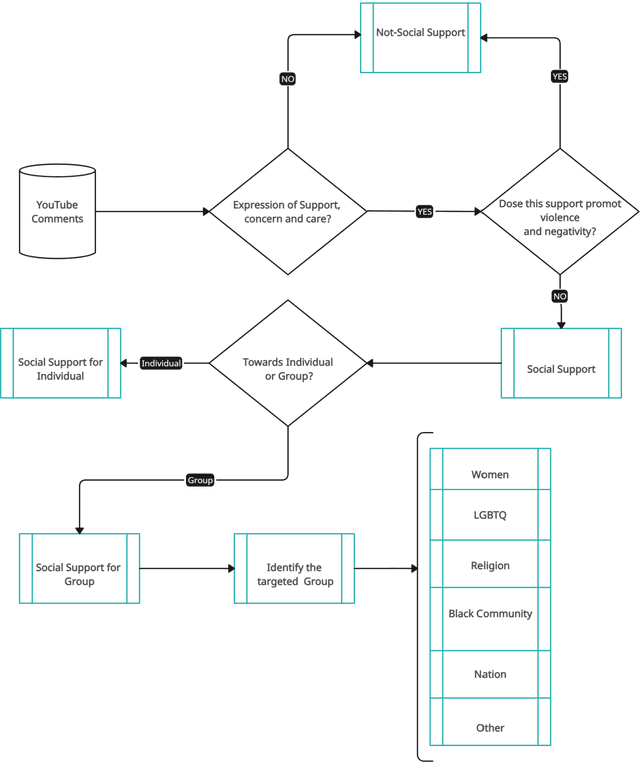

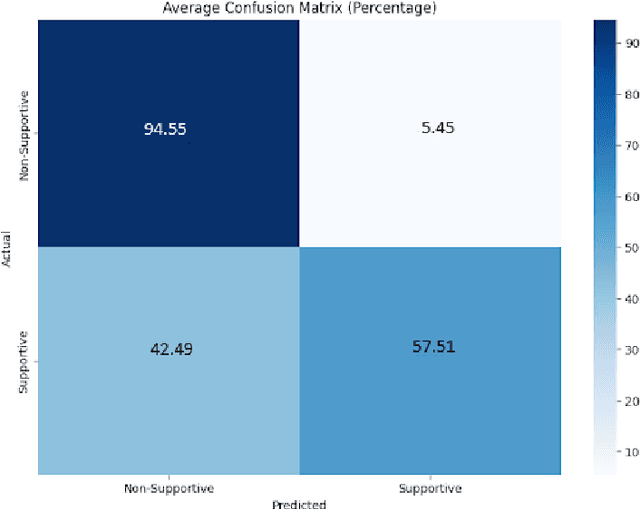
Abstract:Social support, conveyed through a multitude of interactions and platforms such as social media, plays a pivotal role in fostering a sense of belonging, aiding resilience in the face of challenges, and enhancing overall well-being. This paper introduces Social Support Detection (SSD) as a Natural language processing (NLP) task aimed at identifying supportive interactions within online communities. The study presents the task of Social Support Detection (SSD) in three subtasks: two binary classification tasks and one multiclass task, with labels detailed in the dataset section. We conducted experiments on a dataset comprising 10,000 YouTube comments. Traditional machine learning models were employed, utilizing various feature combinations that encompass linguistic, psycholinguistic, emotional, and sentiment information. Additionally, we experimented with neural network-based models using various word embeddings to enhance the performance of our models across these subtasks.The results reveal a prevalence of group-oriented support in online dialogues, reflecting broader societal patterns. The findings demonstrate the effectiveness of integrating psycholinguistic, emotional, and sentiment features with n-grams in detecting social support and distinguishing whether it is directed toward an individual or a group. The best results for different subtasks across all experiments range from 0.72 to 0.82.
Exploring Sentiment Dynamics and Predictive Behaviors in Cryptocurrency Discussions by Few-Shot Learning with Large Language Models
Sep 04, 2024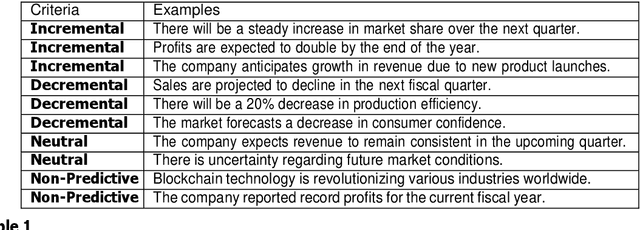
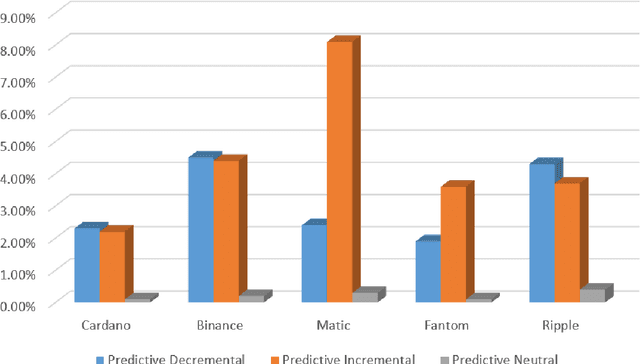
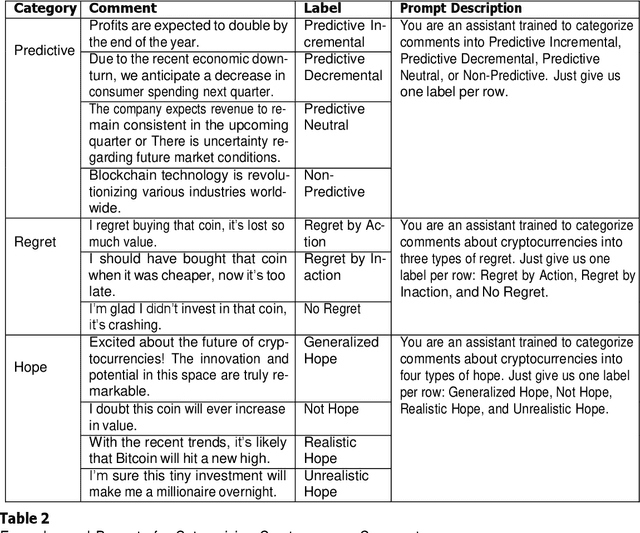
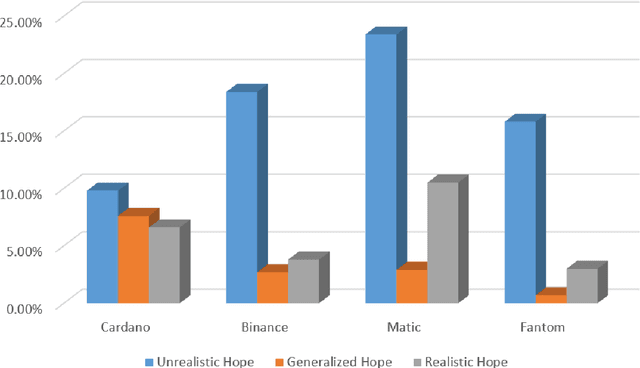
Abstract:This study performs analysis of Predictive statements, Hope speech, and Regret Detection behaviors within cryptocurrency-related discussions, leveraging advanced natural language processing techniques. We introduce a novel classification scheme named "Prediction statements," categorizing comments into Predictive Incremental, Predictive Decremental, Predictive Neutral, or Non-Predictive categories. Employing GPT-4o, a cutting-edge large language model, we explore sentiment dynamics across five prominent cryptocurrencies: Cardano, Binance, Matic, Fantom, and Ripple. Our analysis reveals distinct patterns in predictive sentiments, with Matic demonstrating a notably higher propensity for optimistic predictions. Additionally, we investigate hope and regret sentiments, uncovering nuanced interplay between these emotions and predictive behaviors. Despite encountering limitations related to data volume and resource availability, our study reports valuable discoveries concerning investor behavior and sentiment trends within the cryptocurrency market, informing strategic decision-making and future research endeavors.
FC-KAN: Function Combinations in Kolmogorov-Arnold Networks
Sep 03, 2024Abstract:In this paper, we introduce FC-KAN, a Kolmogorov-Arnold Network (KAN) that leverages combinations of popular mathematical functions such as B-splines, wavelets, and radial basis functions on low-dimensional data through element-wise operations. We explore several methods for combining the outputs of these functions, including sum, element-wise product, the addition of sum and element-wise product, quadratic function representation, and concatenation. In our experiments, we compare FC-KAN with multi-layer perceptron network (MLP) and other existing KANs, such as BSRBF-KAN, EfficientKAN, FastKAN, and FasterKAN, on the MNIST and Fashion-MNIST datasets. A variant of FC-KAN, which uses a combination of outputs from B-splines and Difference of Gaussians (DoG) in the form of a quadratic function, outperformed all other models on the average of 5 independent training runs. We expect that FC-KAN can leverage function combinations to design future KANs. Our repository is publicly available at: https://github.com/hoangthangta/FC_KAN.
A multitask learning framework for leveraging subjectivity of annotators to identify misogyny
Jun 22, 2024Abstract:Identifying misogyny using artificial intelligence is a form of combating online toxicity against women. However, the subjective nature of interpreting misogyny poses a significant challenge to model the phenomenon. In this paper, we propose a multitask learning approach that leverages the subjectivity of this task to enhance the performance of the misogyny identification systems. We incorporated diverse perspectives from annotators in our model design, considering gender and age across six profile groups, and conducted extensive experiments and error analysis using two language models to validate our four alternative designs of the multitask learning technique to identify misogynistic content in English tweets. The results demonstrate that incorporating various viewpoints enhances the language models' ability to interpret different forms of misogyny. This research advances content moderation and highlights the importance of embracing diverse perspectives to build effective online moderation systems.
Anime Popularity Prediction Before Huge Investments: a Multimodal Approach Using Deep Learning
Jun 21, 2024Abstract:In the japanese anime industry, predicting whether an upcoming product will be popular is crucial. This paper presents a dataset and methods on predicting anime popularity using a multimodal textimage dataset constructed exclusively from freely available internet sources. The dataset was built following rigorous standards based on real-life investment experiences. A deep neural network architecture leveraging GPT-2 and ResNet-50 to embed the data was employed to investigate the correlation between the multimodal text-image input and a popularity score, discovering relevant strengths and weaknesses in the dataset. To measure the accuracy of the model, mean squared error (MSE) was used, obtaining a best result of 0.011 when considering all inputs and the full version of the deep neural network, compared to the benchmark MSE 0.412 obtained with traditional TF-IDF and PILtotensor vectorizations. This is the first proposal to address such task with multimodal datasets, revealing the substantial benefit of incorporating image information, even when a relatively small model (ResNet-50) was used to embed them.
 Add to Chrome
Add to Chrome Add to Firefox
Add to Firefox Add to Edge
Add to Edge